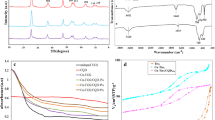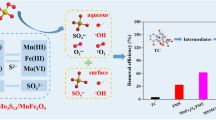Abstract
In this study, a Bi2Fe4O9 catalyst with nanoplate morphology was fabricated using a facile hydrothermal method. It was used as a catalyst to activate peroxymonosulfate (PMS) for aqueous sulfamethoxazole (SMX) removal. A comprehensive performance evaluation of the Bi2Fe4O9/PMS system was conducted by investigating the effects of pH, PMS dosage, catalyst loading, SMX concentration, temperature, and halides (Cl− and Br−) on the degradation of SMX. The Bi2Fe4O9/PMS system demonstrated a remarkable catalytic activity with >95% SMX removal within 30 min (conditions: pH 3.8, [Bi2Fe4O9] = 0.1 g L−1, [SMX]:[PMS] mol ratio =1:20). It was found that both Cl− and Br− can lead to the formation of PMS–induced reactive halide species (i.e. HClO, HBrO, and Br2) which can also react with SMX forming halogenated SMX byproducts. Based on the detected degradation byproducts, the major SMX degradation pathway in the Bi2Fe4O9/PMS system is proposed. The SMX degradation by Bi2Fe4O9/PMS system in the wastewater secondary effluent (SE) was also investigated. The results showed that SMX degradation rate in the SE was relatively slower than in the deionized water due to (i) reactive radical scavenging by water matrix species found in SE (e.g.: dissolved organic matters (DOCs), etc.), and (ii) partial deactivation of the catalyst by DOCs. Nevertheless, the selectivity of the SO4•− towards SMX degradation was evidenced from the rapid SMX degradation despite the high background DOCs in the SE. At least four times the dosage of PMS is required for SMX degradation in the SE to achieve a similar SMX removal efficiency to that of the deionized water matrix.









Similar content being viewed by others
References
Alexy R, Kümpel T, Kümmerer K (2004) Assessment of degradation of 18 antibiotics in the closed bottle test. Chemosphere 57(6):505–512
Amin D, Shaba B (1988) An application of a bromine reagent to the assay of sulfa drugs. Microchem J 37(1):30–35
Buxton GV, Greenstock CL, Helman WP, Ross AB (1988) Critical review of rate constants for reactions of hydrated electrons, hydrogen atoms and hydroxyl radicals (⋅OH/⋅ O− in aqueous solution). J Phys Chem Ref Data 17(2):513–886
Deng J, Feng S, Ma X, Tan C, Wang H, Zhou S, Zhang T, Li J (2016) Heterogeneous degradation of Orange II with peroxymonosulfate activated by ordered mesoporous MnFe2O4. Sep Purif Technol 167:181–189
Dmitrienko SG, Kochuk EV, Apyari VV, Tolmacheva VV, Zolotov YA (2014) Recent advances in sample preparation techniques and methods of sulfonamides detection—a review. Anal Chim Acta 850:6–25
Dodd MC, Huang C-H (2004) Transformation of the antibacterial agent sulfamethoxazole in reactions with chlorine: kinetics, mechanisms, and pathways. Environmental Science & Technology 38(21):5607–5615
El-Ghenymy A, Rodríguez RM, Brillas E, Oturan N, Oturan MA (2014) Electro-Fenton degradation of the antibiotic sulfanilamide with Pt/carbon-felt and BDD/carbon-felt cells. Kinetics, reaction intermediates, and toxicity assessment. Environ Sci Pollut Res 21(14):8368–8378
Gao S, Zhao Z, Xu Y, Tian J, Qi H, Lin W, Cui F (2014) Oxidation of sulfamethoxazole (SMX) by chlorine, ozone and permanganate—a comparative study. J Hazard Mater 274:258–269
Ghanbari F, Moradi M (2017) Application of peroxymonosulfate and its activation methods for degradation of environmental organic pollutants: review. Chem Eng J 310:41–62
Ghanbari F, Moradi M, Manshouri M (2014) Textile wastewater decolorization by zero valent iron activated peroxymonosulfate: compared with zero valent copper. Journal of Environmental Chemical Engineering 2(3):1846–1851
Ghanbari F, Moradi M, Gohari F (2016) Degradation of 2,4,6-trichlorophenol in aqueous solutions using peroxymonosulfate/activated carbon/UV process via sulfate and hydroxyl radicals. Journal of Water Process Engineering 9:22–28
Gong F, Wang L, Li D, Zhou F, Yao Y, Lu W, Huang S, Chen W (2015) An effective heterogeneous iron-based catalyst to activate peroxymonosulfate for organic contaminants removal. Chem Eng J 267:102–110
Guan Y-H, Ma J, Li X-C, Fang J-Y, Chen L-W (2011) Influence of pH on the formation of sulfate and hydroxyl radicals in the UV/peroxymonosulfate system. Environmental Science & Technology 45(21):9308–9314
Guo W, Su S, Yi C, Ma Z (2013) Degradation of antibiotics amoxicillin by Co3O4-catalyzed peroxymonosulfate system. Environmental Progress & Sustainable Energy 32(2):193–197
He X, de la Cruz AA, Dionysiou DD (2013) Destruction of cyanobacterial toxin cylindrospermopsin by hydroxyl radicals and sulfate radicals using UV-254 nm activation of hydrogen peroxide, persulfate and peroxymonosulfate. J Photochem Photobiol A Chem 251:160–166
Hirsch R, Ternes T, Haberer K, Kratz K-L (1999) Occurrence of antibiotics in the aquatic environment. Sci Total Environ 225(1–2):109–118
Hu Z-T, Liu J, Yan X, Oh W-D, Lim T-T (2015a) Low-temperature synthesis of graphene/Bi2Fe4O9 composite for synergistic adsorption-photocatalytic degradation of hydrophobic pollutant under solar irradiation. Chem Eng J 262(0):1022–1032
Hu Z-T, Lua SK, Lim T-T (2015b) Cuboid-like Bi2Fe4O9/Ag with graphene-wrapping tribrid composite with superior capability for environmental decontamination: Nanoscaled material design and visible-light-driven multifunctional catalyst. ACS Sustain Chem Eng 3(11):2726–2736
Hu Z-T, Chen Z, Goei R, Wu W, Lim T-T (2016) Magnetically recyclable Bi/Fe-based hierarchical nanostructures via self-assembly for environmental decontamination. Nanoscale 8(25):12736–12746
Huang Y-H, Huang Y-F, Huang C-i, Chen C-Y (2009) Efficient decolorization of azo dye Reactive Black B involving aromatic fragment degradation in buffered Co2+/PMS oxidative processes with a ppb level dosage of Co2+-catalyst. J Hazard Mater 170(2–3):1110–1118
Ji Y, Ferronato C, Salvador A, Yang X, Chovelon J-M (2014) Degradation of ciprofloxacin and sulfamethoxazole by ferrous-activated persulfate: implications for remediation of groundwater contaminated by antibiotics. Sci Total Environ 472:800–808
Ji Y, Fan Y, Liu K, Kong D, Lu J (2015) Thermo activated persulfate oxidation of antibiotic sulfamethoxazole and structurally related compounds. Water Res 87:1–9
Kümmerer K (2009) Antibiotics in the aquatic environment—a review—part I. Chemosphere 75(4):417–434
Liebig M, Moltmann J, Knacker T (2006) Evaluation of measured and predicted environmental concentrations of selected human pharmaceuticals and personal care products (10 pp). Environ Sci Pollut Res 13(2):110–119
Lin K-YA, Chang H-A (2015) Zeolitic Imidazole Framework-67 (ZIF-67) as a heterogeneous catalyst to activate peroxymonosulfate for degradation of Rhodamine B in water. Journal of the Taiwan Institute of Chemical Engineers 53:40–45
Lin K-YA, Chen B-J (2017) Prussian blue analogue derived magnetic carbon/cobalt/iron nanocomposite as an efficient and recyclable catalyst for activation of peroxymonosulfate. Chemosphere 166:146–156
Lin K-YA, Chang H-A, Chen R-C (2015) MOF-derived magnetic carbonaceous nanocomposite as a heterogeneous catalyst to activate oxone for decolorization of Rhodamine B in water. Chemosphere 130:66–72
Lin K-YA, Chen Y-C, Huang C-F (2016) Magnetic carbon-supported cobalt prepared from one-step carbonization of hexacyanocobaltate as an efficient and recyclable catalyst for activating Oxone. Sep Purif Technol 170:173–182
Lopez-Ramon MV, Stoeckli F, Moreno-Castilla C, Carrasco-Marin F (1999) On the characterization of acidic and basic surface sites on carbons by various techniques. Carbon 37(8):1215–1221
Lutze HV, Bakkour R, Kerlin N, von Sonntag C, Schmidt TC (2014) Formation of bromate in sulfate radical based oxidation: mechanistic aspects and suppression by dissolved organic matter. Water Res 53:370–377
Lutze HV, Bircher S, Rapp I, Kerlin N, Bakkour R, Geisler M, von Sonntag C, Schmidt TC (2015a) Degradation of Chlorotriazine pesticides by sulfate radicals and the influence of organic matter. Environmental Science & Technology 49(3):1673–1680
Lutze HV, Kerlin N, Schmidt TC (2015b) Sulfate radical-based water treatment in presence of chloride: formation of chlorate, inter-conversion of sulfate radicals into hydroxyl radicals and influence of bicarbonate. Water Res 72(0):349–360
Mahdi Ahmed M, Barbati S, Doumenq P, Chiron S (2012) Sulfate radical anion oxidation of diclofenac and sulfamethoxazole for water decontamination. Chem Eng J 197(0):440–447
Neta P, Madhavan V, Zemel H, Fessenden RW (1977) Rate constants and mechanism of reaction of sulfate radical anion with aromatic compounds. J Am Chem Soc 99(1):163–164
Oh W-D, Lua S-K, Dong Z, Lim T-T (2014) High surface area DPA-hematite for efficient detoxification of bisphenol A via peroxymonosulfate activation. J Mater Chem A 2(38):15836–15845
Oh W-D, Dong Z, Hu Z-T, Lim T-T (2015a) A novel quasi-cubic CuFe2O4-Fe2O3 catalyst prepared at low temperature for enhanced oxidation of bisphenol A via peroxymonosulfate activation. J Mater Chem A 3(44):22208–22217
Oh W-D, Lua S-K, Dong Z, Lim T-T (2015b) A novel three-dimensional spherical CuBi2O4 consisting of nanocolumn arrays with persulfate and peroxymonosulfate activation functionalities for 1H-benzotriazole removal. Nanoscale 7(17):8149–8158
Oh W-D, Dong Z, Lim T-T (2016a) Generation of sulfate radical through heterogeneous catalysis for organic contaminants removal: current development, challenges and prospects. Appl Catal B Environ 194:169–201
Oh W-D, Lua S-K, Dong Z, Lim T-T (2016b) Rational design of hierarchically-structured CuBi2O4 composites by deliberate manipulation of the nucleation and growth kinetics of CuBi2O4 for environmental applications. Nanoscale 8(4):2046–2054
Oh W-D, Dong Z, Lim T-T (2017a) Hierarchically-structured Co–CuBi2O4 and Cu–CuBi2O4 for sulfanilamide removal via peroxymonosulfate activation. Catal Today 280(Part 1):2–7
Oh W-D, Dong Z, Ronn G, Lim T-T (2017b) Surface–active bismuth ferrite as superior peroxymonosulfate activator for aqueous sulfamethoxazole removal: performance, mechanism and quantification of sulfate radical. J Hazard Mater 325:71–81
Polczynski P, Jurczakowski R, Grochala W (2013) Stabilization and strong oxidizing properties of Ag(ii) in a fluorine-free solvent. Chem Commun 49(68):7480–7482
Rastogi A, Al-Abed SR, Dionysiou DD (2009) Sulfate radical-based ferrous–peroxymonosulfate oxidative system for PCBs degradation in aqueous and sediment systems. Appl Catal B Environ 85(3–4):171–179
Ruan Q-J, Zhang W-D (2009) Tunable morphology of Bi2Fe4O9 crystals for photocatalytic oxidation. J Phys Chem C 113(10):4168–4173
Saputra E, Muhammad S, Sun H, Ang HM, Tade MO, Wang S 2013. Different crystallographic one-dimensional MnO2 nanomaterials and their superior performance in catalytic phenol degradation. Environmental Science & Technology
Saputra E, Muhammad S, Sun H, Ang H-M, Tadé MO, Wang S (2014) Shape-controlled activation of peroxymonosulfate by single crystal α-Mn2O3 for catalytic phenol degradation in aqueous solution. Appl Catal B Environ 154–155:246–251
Saputra E, Zhang H, Liu Q, Sun H, Wang S (2016) Egg-shaped core/shell α-Mn2O3@α-MnO2 as heterogeneous catalysts for decomposition of phenolics in aqueous solutions. Chemosphere 159:351–358
Shao P, Duan X, Xu J, Tian J, Shi W, Gao S, Xu M, Cui F, Wang S (2017) Heterogeneous activation of peroxymonosulfate by amorphous boron for degradation of bisphenol S. J Hazard Mater 322(Part B):532–539
Shon HK, Vigneswaran S, Snyder SA (2006) Effluent organic matter (EfOM) in wastewater: constituents, effects, and treatment. Crit Rev Environ Sci Technol 36(4):327–374
Shukla P, Sun H, Wang S, Ang HM, Tadé MO (2011) Co-SBA-15 for heterogeneous oxidation of phenol with sulfate radical for wastewater treatment. Catal Today 175(1):380–385
Wang P, Yang S, Shan L, Niu R, Shao X (2011) Involvements of chloride ion in decolorization of Acid Orange 7 by activated peroxydisulfate or peroxymonosulfate oxidation. J Environ Sci 23(11):1799–1807
Xie W, Dong W, Kong D, Ji Y, Lu J, Yin X (2016) Formation of halogenated disinfection by-products in cobalt-catalyzed peroxymonosulfate oxidation processes in the presence of halides. Chemosphere 154:613–619
Ximenes VF, Morgon NH, de Souza AR (2015) Hypobromous acid, a powerful endogenous electrophile: experimental and theoretical studies. J Inorg Biochem 146:61–68
Yang B, Tian Z, Wang B, Sun Z, Zhang L, Guo Y, Li H, Yan S (2015) Facile synthesis of Fe3O4/hierarchical-Mn3O4/graphene oxide as a synergistic catalyst for activation of peroxymonosulfate for degradation of organic pollutants. RSC Adv 5(27):20674–20683
Zhang W, Tay HL, Lim SS, Wang Y, Zhong Z, Xu R (2010) Supported cobalt oxide on MgO: highly efficient catalysts for degradation of organic dyes in dilute solutions. Appl Catal B Environ 95(1–2):93–99
Zhang T, Zhu H, Croué J-P (2013) Production of sulfate radical from peroxymonosulfate induced by a magnetically separable CuFe2O4 spinel in water: efficiency, stability, and mechanism. Environmental Science & Technology 47(6):2784–2791
Zhang B-T, Zhang Y, Teng Y, Fan M (2015) Sulfate radical and its application in decontamination technologies. Crit Rev Environ Sci Technol 45(16):1756–1800
Author information
Authors and Affiliations
Corresponding authors
Additional information
Responsible editor: Suresh Pillai
Electronic supplementary material
ESM 1
(PDF 502 kb)
Rights and permissions
About this article
Cite this article
Oh, WD., Chang, V.W. & Lim, TT. A comprehensive performance evaluation of heterogeneous Bi2Fe4O9/peroxymonosulfate system for sulfamethoxazole degradation. Environ Sci Pollut Res 26, 1026–1035 (2019). https://doi.org/10.1007/s11356-017-8476-9
Received:
Accepted:
Published:
Issue Date:
DOI: https://doi.org/10.1007/s11356-017-8476-9




